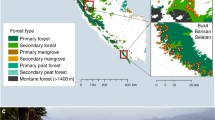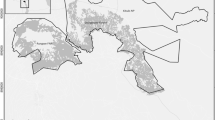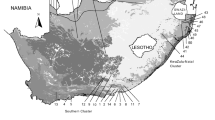Abstract
Three species of tortoise (Testudinidae) occur in Greece (Testudo hermanni, T. graeca and the endemic T. marginata), all of which have been listed as rare or vulnerable. This paper describes the current situation of 75 populations that were last observed in the 1970s and 1980s and described in 1989. Twenty-nine populations had declined in density and/or status (significantly more than had improved), 10 of which were functionally extinct. A particularly notable loss was a dense population of T. marginata at Gytheion in the Peloponnese due to a widespread fire. Declining populations were significantly associated with identified high threat in 1989 and with close proximity to human settlement. There were no significant effects of tortoise species, area of site, characteristics of surrounding areas or original density on these changes. Declines were less associated with agriculture than predicted in 1989, reflecting changing economic conditions in Greece in the 1990s. Continuing threats to tortoise habitats make their long-term future appear bleak outside of protected areas. The risk of extinction from stochastic variation in small populations was also assessed, using the VORTEX program. This risk was much lower than that from habitat loss; 60–96% of populations of 100 tortoises would survive for 1000 years, depending on adult body size, compared to only 0–0.02% of habitats. The high survival potential of small populations would facilitate conservation of the high intraspecific diversity of tortoises in Greece.
Similar content being viewed by others
References
Auffenberg W. and Franz R. 1982. The status and distribution of the gopher tortoise (Gopherus polyphemus). Wildlife Research Reports 12: 95–126.
Berry K.H. 1997. The desert tortoise recovery plan: an ambitious effort to conserve biodiversity in the Mojave and Colorado deserts of the United States. In: Van Abbema J. (ed.), Proceedings: Conservation, Restoration, and Management of Tortoises and Turtles - An International Conference. New York Turtle and Tortoise Society, New York, pp. 430–440.
Bour R. 1996. Une nouvelle espece de tortue terrestre dans le Peloponnese (Grece). Dumerilia 2: 23–54.
Bringsøe H., Buskirk J.R. and Willemsen R.E. 2001. Testudo marginata Schoepff, 1792-Breitrandschildkrote. In: Bohme W. (ed.), Handbuch der Reptilien und Amphibien Europas. Vol 3/ IIIA: Schildkroten (Testudines) I (Bataguridae, Testudinidae, Emydidae). Aula-Verlag, Wiebelsheim, Germany, pp. 291–334.
Corbett K. 1989. Conservation of European Reptiles and Amphibians. Helm, London.
Hailey A. 1988. Population ecology and conservation of tortoises: the estimation of density, and dynamics of a small population. Herpetological Journal 1: 263–271.
Hailey A. 1989. How far do animals move? Routine movements in a tortoise. Canadian Journal of Zoology 67: 208–215.
Hailey A. 1990. Adult survival and recruitment and the explanation of an uneven sex ratio in a tortoise population. Canadian Journal of Zoology 68: 547–555.
Hailey A. 2000a. The effects of fire and mechanical habitat destruction on survival of the tortoise Testudo hermanni in northern Greece. Biological Conservation 92: 321–333.
Hailey A. 2000b. Implications of high intrinsic growth rate of a tortoise population for conservation. Animal Conservation 3: 185–189.
Hailey A. and Goutner V. 2002. Changes in the Alyki Kitrous wetland in northern Greece: 1990-1999, and future prospects. Biodiversity and Conservation 11: 357–377.
Hailey A. and Loumbourdis N.S. 1988. Egg size and shape, clutch dynamics, and reproductive effort in European tortoises. Canadian Journal of Zoology 66: 1527–1536.
Hailey A. and Willemsen R.E. 2000. Population density and adult sex ratio of the tortoise Testudo hermanni in Greece: evidence for intrinsic population regulation. Journal of Zoology London 251: 325–338.
Hailey A., Wright J. and Steer E. 1988. Population ecology and conservation of tortoises: the effects of disturbance. Herpetological Journal 1: 294–301.
IUCN 1990. 1990 IUCN Red List of Threatened Animals. IUCN, Gland, Switzerland.
IUCN 2000. 2000 IUCN Red List of Threatened Animals. IUCN, Gland, Switzerland.
Kinnear P.R. and Gray C.D. 1997. SPSS For Windows Made Simple. 2nd edn. Psychology Press, Hove, UK.
Lacy R.C. 1993. VORTEX: a computer simulation model for population viability analysis. Wildlife Research 20: 45–65.
Lambert M.R.K. 1984. Threats to Mediterranean (West Palaearctic) tortoises and their effects on wild populations: an overview. Amphibia-Reptilia 5: 5–15.
Longepierre S., Hailey A. and Grenot C. 2001. Home range area in the tortoise Testudo hermanni in relation to habitat complexity: implications for conservation of biodiversity. Biodiversity and Conservation 10: 1131–1140.
Mascort R. 1997. Land tortoises in Spain: their status and conservation. In: Van Abbema J. (ed.), Proceedings: Conservation, Restoration, and Management of Tortoises and Turtles - An International Conference. New York Turtle and Tortoise Society, New York, pp. 307–312.
Miller P.S. and Lacy R.C. 1999. VORTEX Version 8 Users Manual: A Stochastic Simulation of the Extinction Process. IUCN/SSC Conservation Breeding Specialist Group, Apple Valley, Minnesota.
Myers N. 1990. The biodiversity challenge: expanded hotspot analysis. The Environmentalist 10: 243–256.
O'sullivan F. 1972. The Egnatian Way. David and Charles, Newton Abbott, UK.
Pritchard P.C.H. 1997. Conservation strategies - an overview: implications for management. In: Van Abbema J. (ed.), Proceedings: Conservation, Restoration, and Management of Tortoises and Turtles - An International Conference. New York Turtle and Tortoise Society, New York, pp. 467–471.
Purvis A., Agapow P.-M., Gittleman J.L. and Mace G.M. 2000. Non-random extinction and the loss of evolutionary history. Science 288: 328–330.
Smith L.L., Reid D., Robert B., Joby M. and Clement S. 1999. Status and distribution of the angonoka tortoise (Geochelone yniphora) of western Madagascar. Biological Conservation 91: 23–33.
Stubbs D., Hailey A., Pulford E. and Tyler W. 1981. Expedition to Greece 1980. University of London Natural History Society, London.
Stubbs D., Swingland I.R., Hailey A. and Pulford E. 1985. The ecology of the Mediterranean tortoise Testudo hermanni in northern Greece: the effects of a catastrophe on population structure and density. Biological Conservation 31: 125–152.
Troumbis A.Y. and Dimitrakopoulos P.G. 1998. Geographic coincidence of diversity threatspots for three taxa and conservation planning in Greece. Biological Conservation 84: 1–6.
Willemsen R.E. and Hailey A. 1989. Status and conservation of tortoises in Greece. Herpetological Journal 1: 315–330.
Willemsen R.E. and Hailey A. 1999a. Variation of adult body size of the tortoise Testudo hermanni in Greece: proximate and ultimate causes. Journal of Zoology London 248: 379–396.
Willemsen R.E. and Hailey A. 1999b. A latitudinal cline of dark plastral pigmentation in the tortoise Testudo hermanni in Greece. Herpetological Journal 9: 125–132.
Willemsen R.E. and Hailey A. 2001a. Variation in adult survival rate of the tortoise Testudo hermanni in Greece: implications for evolution of body size. Journal of Zoology London 255: 43–53.
Willemsen R.E. and Hailey A. 2001b. Effects of the herbicides 2,4-D and 2,4,5-T on a population of the tortoise Testudo hermanni in southern Greece. Environmental Pollution 113: 71–78.
Wright J., Steer E. and Hailey A. 1988. Habitat separation in tortoises and the consequences for activity and thermoregulation. Canadian Journal of Zoology 66: 1537–1544.
Rights and permissions
About this article
Cite this article
Hailey, A., Willemsen, R. Changes in the status of tortoise populations in Greece 1984–2001. Biodiversity and Conservation 12, 991–1011 (2003). https://doi.org/10.1023/A:1022815120619
Issue Date:
DOI: https://doi.org/10.1023/A:1022815120619




